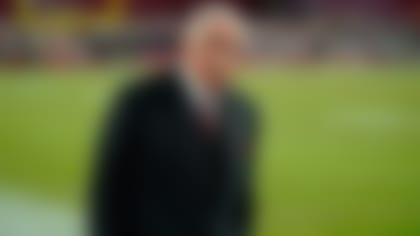SANTA CLARA, Calif. -- Goodbye cold, grungy Candlestick Park. Hello high tech, shiny new Levi's Stadium.
Fifty-four years after $32 million Candlestick Park opened, the 49ers are building a new, $1.2 billion showcase of a stadium which is almost twice as big, wired to the hilt, and opening its doors just in time to host Super Bowl 50 in the heart of the Silicon Valley.
"If you're a fan and you go to Candlestick, then you will really appreciate this new stadium," said project executive Jack Hill, standing on the building's 200-foot-high roof, gazing out at the south tip of the San Francisco Bay. "It's going to be the crowning glory of the NFL."
The airy, open stadium had an intimate feel; with the largest lower bowl in the league, the 68,500 fans are close to the action. And that closeness is mutual. When players burst through the blowing smoke and blasting music on game day, they'll be able to make eye contact with every seat, even the corner nosebleeds who are dwarfed beneath some of the largest high definition jumbotrons in the league.
"This stadium is tremendous for the team. It helps strengthen the brand, because the one negative thing about the 49ers has always been Candlestick Park," said University of Southern California professor Jeff Fellenzer, who teaches sports, business and media.
The steep construction bills are being paid by $800 million in seat and luxury box sales, along with a 20-year, $220 million naming rights agreement with Levi Strauss and Co. announced May 8, clinching a partnership with the company that added copper rivets to denim pants 150 years ago to create the first blue jeans for California's rugged gold miners, the so-called 49ers. A few weeks later, the NFL chose the stadium for the 2016 Super Bowl.
While they're in the black now, funding for the stadium has come with its share of rancor.
"Our city has long deferred more important projects," writes resident Bill Bailey, who heads a coalition of Santa Clara residents concerned that accommodating the 49ers draws funds away from critical needs like public libraries. "We believe that Santa Clara should not tax its citizens, increase its debt, or allocate land or any other valuable assets to build a stadium."
The 49ers and the city of Santa Clara initially partnered to build the stadium, with voters approving a $30 million public investment of redevelopment funds. Those funds were unexpectedly yanked by county officials last summer, after Gov. Jerry Brown eliminated all redevelopment agencies in the state.
Team officials still are happier with their new home than the old one.
Notoriously blustery, with fog and wind blowing off the adjacent bay, Candlestick Park, or "The 'Stick," took another hit in 2011 when a pair of blackouts left fans in the dark for more than 20 minutes. It's value is nil: weeks after the last 49ers game next season, the owners plan to blow it up.
EJ Narcise, a principal at Team Services, LLC, a naming rights sports marketing sales and consulting firm in Rockville, Md., said the new stadium should bring new revenue to a team that is been in the bottom third of the NFL in that category.
"Look, they're a great team, but they have missed the revenues generated from the luxury seats, the premiums suites, the concession upgrades and the entertainment," he said.
The 49ers, meanwhile, are trying to make their building the most environmentally friendly stadium in the league. Solar panels will gather enough power so that even on Super Bowl Sunday they won't need to pull electricity from the grid. The grass field and toilets use recycled water, the turf is geothermic, a bicycle valet and racks will welcome cyclists who can pedal in bike paths from miles around, even from the airport.
Today, the 50-yard line is loaded with shipping containers, trucks and port-a-potties to support the 1,100 construction workers buzzing around the site. But the grass is already growing on a turf farm about 90 minutes away, and should be rolled out next March.
A few blocks from the stadium, at the 49ers showcase and sales office, fans on Friday took a virtual stadium walk through at a nine-foot digital touch wall, and sat in a mock-up suite before pulling out their credit cards one after another to buy the rights to eventually buy tickets. Before they did, they had a chance to see a 3-D version of what their view of the stadium would be.
"We're pretty excited. This stadium looks amazing, and it's so close to our home," said Jojo Daquigan, a postal worker in San Jose, who with his wife Cristina, a nurse, had just paid $5,000 in one-time fees for midlevel corner seats.
In keeping with its Silicon Valley base of support, the 49ers' assumption is that fans will be carrying smartphones, so the place will be entirely cash free and ticketless. Software engineers are already building apps for cellphones that will allow fans to order food, watch instant replays, listen to play by play and check bathroom lines from their seats.
And about those bathroom lines? Here, Levi's Stadium offers a definite upgrade: 1,135 toilets, up from Candlestick's 885.
Copyright 2013 by The Associated Press



